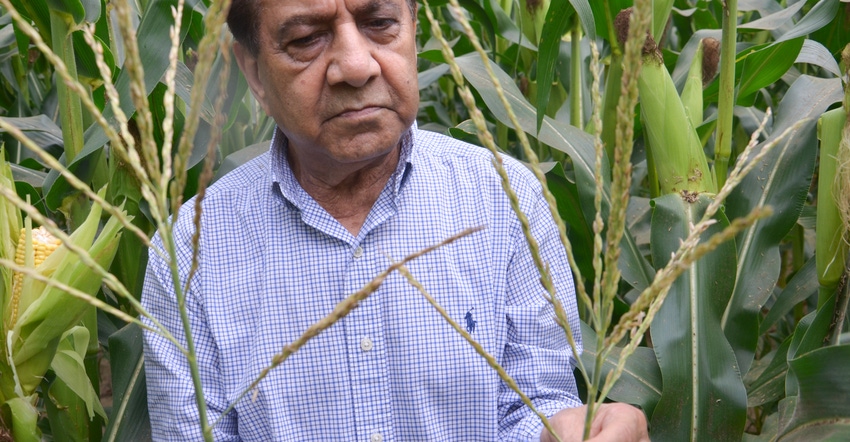
Walk a field with a corn breeder or a corn product specialist, and you likely won’t have to wonder what kind of corn is in the field. Breeders and specialists who work with hybrids on a daily basis can identify many hybrids by their characteristics. One thing they can nearly always do, even if they can’t name the exact genetic family, is distinguish two hybrids in the same field from one another — down to the row.
There are many ways to do that, says Dave Nanda, a corn breeder and crop consultant based in Indianapolis. This time of year, with ears on plants, there’s often a difference in number of rows of kernels per ear among hybrids.
“That is largely a genetic trait.” Nanda says. “It can be influenced somewhat by the environment, but it starts with genetics. Some hybrids typically put on 18 to 20 rows of kernels. Others put on 14 to 16 rows; others maybe only 14. Often the hybrids which don’t put on as many rows of kernels per ears have longer ears. They may also have deeper kernels.”
Nanda monitors the Corn Watch ’18 field regularly. Corn Watch ’18 is sponsored by Seed Genetics-Direct, Washington Court House, Ohio.
So, if you know two hybrids are planted in a field, and you’re trying to find the break walking through the field, you can check number of rows per ear, or overall ear design, and often determine where one hybrid ends and another starts.
“Planting two hybrids together in the same field — one hybrid in half the planter boxes and the second one in the other half — is becoming more common,” Nanda says. “If you do so, make sure there is a difference in days to pollination. It may only be a couple days, but it provides a longer interval with pollen present in the field.”
Before ears
How can you tell hybrids apart earlier in the season, before ears appear? Once tassels emerge, you have a trait to distinguish hybrids, Nanda says. He notes that both the architecture of the tassel and the number of total branches per tassel often vary from hybrid to hybrid.
Recently, Nanda found the break in the Corn Watch ’18 field by looking for differences in tassels. One hybrid had tassels with 12 to 13 branches on each plant. The other hybrid had eight branches per plant.
“It’s a distinct difference and one that is easily recognizable,” Nanda says. “It will be the same wherever you plant those same two hybrids. You can tell which hybrid you’re looking at simply by examining the tassel.”
Plant breeders tend to prefer hybrids today with smaller tassels and fewer branches. “There is still an abundance of pollen on plants with fewer branches,” Nanda explains. “If the plant puts less energy into making a bigger tassel, it has more energy left to fill kernels later. Smaller tassels also result in less shading of upper leaves and let in more light for photosynthesis.”
You wouldn’t make a hybrid selection on tassel size or number of branches alone, but it’s another trait to evaluate and compare, Nanda concludes.
About the Author(s)
You May Also Like




